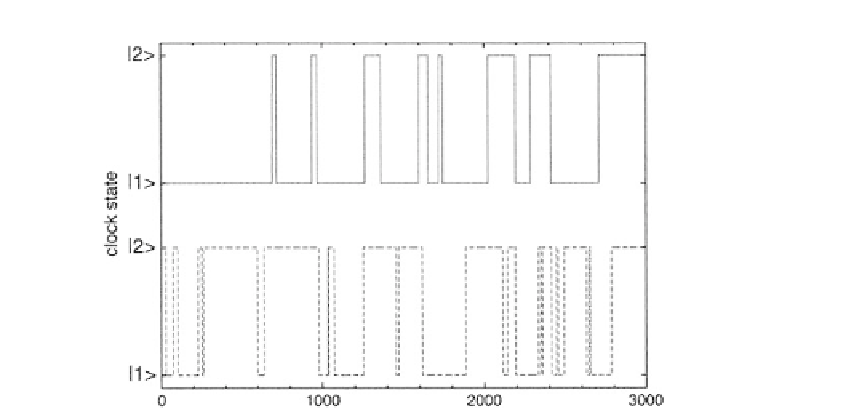Information Technology Reference
In-Depth Information
Figure 7.3.
The typical time series of a single two-state node in a web of the ensemble. The solid line refers
to a positive initial state and the dashed line to a negative initial state. The number of nodes in
the single web of the ensemble is 10
5
, the unperturbed transition rate is
g
=
0
.
01 and the
coupling parameter is
K
=
.
;
1
05
redrawn from [
15
] with permission.
Figure
7.3
confirms the prediction of (
7.20
), showing that if
(
∞
)
=
min
the single
two-state node spends on average more time in the state
r
=
1 and if
(
∞
)
=−
min
the single node spends on average more time in the state
r
2. The probability density
functions for the sojourn times both in the preferred and in the non-preferred states are
exponential functions with different mean sojourn times.
=
7.1.3
Stochastic approximation to a synchronized web
Let us now explore the collective behavior of a single web of
N
two-state nodes under
the all-to-all coupling condition. In order to do this Bianco
et al.
[
15
] introduced a
familiar collective phase variable. The global web variable is defined as
N
1
N
N
1
(
t
)
−
N
2
(
t
)
e
i
j
(
t
)
=
ξ(
t
)
≡
;
(7.21)
N
j
=
1
j
is the phase of the
j
th node and has the value of 0 if the node is in state
r
=
1
and
π
if the node is in the state
r
=
2,
N
1
(
t
)
is the number of nodes in the former
state at time
t
and
N
2
(
is the number of nodes in the latter state at time
t
.Inthe
decision-making model this is the difference between those voting for a candidate and
those voting against. In the mean-field case, when
N
t
)
, the single web becomes a
statistical ensemble of identical nodes. In this case the master equation for the network
is (
7.9
), where
p
r
is the probability that any node in the ensemble is in the state
r
.
Consequently, from the definition of the web variable, we obtain in the mean-field limit
→∞
ξ(
t
)
=
p
1
(
t
)
−
p
2
(
t
)
=
(
t
).
(7.22)


